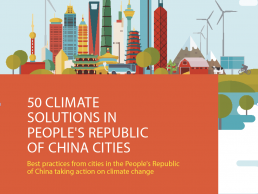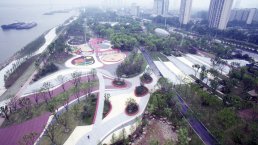First appeared in

Asian Development Bank
50 climate solutions from cities in the People's Republic of China
Wuhan has re-embraced nature to make its city safe from flooding, while also providing the world’s largest beach park for the city’s nine million citizens to enjoy.
The Chinese megacity, Wuhan, is rehabilitating the embankment of the Yangtze River, as monsoon rains have broken all records in recent years and exposed the city’s inadequate flood defences. Historically, giant dikes lined the river banks, protecting riverside neighborhoods, but during extreme summer rainfall these systems failed. The city is now dismantling old defenses and instead embracing the natural protection qualities of vegetation. By modifying the embankment with a gentle slope, the area has now become the Yangtze River Beach Park.
724
TONS OF CARBON ARE SEQUESTERED ANNUALLY BY VEGETATION IN THE YANGTZE RIVER BEACH PARK
The newly established Beach Park is more than 7 km long and contains a vegetation buffer strip, 700,000 m2 of green park area, including 45,000 trees and rain gardens, which naturally filter polluted runoff water and defend Wuhan from intense storm events. Social perks add further value to the development. Fifteen kilometers of non- motorized roads, seven swimming pools, and 15 football courts cater to the 3.2 million people who have visited the park so far. A part of the PRC’s 13th Five Year Plan, the park is to become the largest urban riverfront park in the world at 10 million m2

As green areas account for 70% of the Yangtze River Beach Park, the local environment is improved and carbon sequestration increased.
The Challenge
In 2016, Wuhan experienced its worst rain in 18 years, reaching up to 1,087.2 mm in some districts, affect- ing 1.7 million people and causing almost CNY 26.5 billion in damages. The rainfall exceeded 100-year stan- dards of 344 mm, and the flood level reached 1 m higher than the average warning level.
Co-Benefits
Economic Since the completion of the first phase of construction, the value of land in areas surrounding the park has more than doubled.
Environment In addition to thousands of trees, 325,000 m2 of shrubs and 387,000 m2 of grass have been planted, improving the regional microclimate and lowering the urban heat island effect, with a drop in temperature of three degrees.
Social Turning the embankment into a beach with non-polluted water and a park for recreational activities is enhancing public health and quality of life for city residents.

